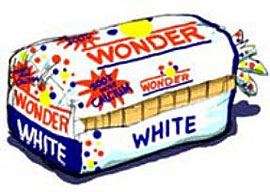
January 08, 2014

But if you aren’t going to make your family’s sandwiches from bread you baked yourself and from sausages you ground yourself, how do you know your baker and butcher aren’t just, say, tossing in dead cockroaches they swept up off the floor? What if the factory is adding strong flavors to cover up filler? How can you tell that your delicious store-bought dark rye bread isn’t infected with the brownish-purple ergot of rye mold, which can cause the neurological disorder St. Vitus’s Dance?
One solution favored by some immigrant groups was to rely upon a trusted neighborhood delicatessen with famously high standards. The ethnic deli method was especially popular with cultures that traditionally endorsed complicated food taboos that made it difficult to share a convivial meal with outsiders. Of course, it also tended to exacerbate immigrant ethnocentrism, making them nervous when they dined away from their home turf, as when Alvy Singer tries to eat an Easter ham with Annie Hall’s family.
In contrast, the Pure Foods Movement that WASP ladies (many of whom were also in the temperance struggle) started after the Civil War sought to find remedies for their more open and mobile culture. One was federal regulation: The coalition finally succeeded in passing the Pure Food and Drug Act in 1906 after the publication of Upton Sinclair’s muckraking The Jungle.
Another tactic was favoring lighter-colored and lighter-flavored foodstuffs that were harder to pollute.
And it worked. A scientist wrote in 1926 of trends in bread, “To all appearances…the general public is continuing in its belief (justified both by the bacteriological count and the microscopic examination) that whiteness or creamy whiteness is a sign of cleanness.”
Whiteness was next to cleanliness. A non-food example was Procter & Gamble introducing in 1881 a famous slogan to sell their Ivory Soap bars: “99 and 44/100ths pure.” By today’s standards, a packaged good that is advertised as 0.56 percent random crud sounds like trouble, but in 1881 that marked a new benchmark in quality control.
(Similarly, Asians have been demanding to have much of the nutrients polished off their rice for centuries, in part because it’s harder to hide contaminants in white rice.)
Before the spread of franchised fast-food restaurants with standardized methods, travelers were highly concerned about where and what to eat without suffering food poisoning. It was widely believed that the safest meal to eat in a strange diner was a grilled-cheese sandwich. As NPR reported on Bobrow-Strain’s research: “And some foods are just better with white bread, he says, whether it’s a simple grilled cheese or something fancier.”
Milton Berle learned the prudential wisdom of eating white during his years on the road. Johns notes:
You wouldn’t guess from Berle’s joke that he himself took his corned beef with mayo on white, a preference he attributed to a nomadic showbiz youth fueled by pit stops at railroad lunch counters in the 1920s.
An alternative to whiteness was for a brand to advertise heavily to build glamour and confidence that its products weren’t put out by some fly-by-night operation. The most famous representative of the dark side of American consumables was Coca-Cola, whose brown syrup was based on an ostentatiously secret recipe, one that came with jolts of caffeine and, for decades, cocaine.
Eventually, the goals of the Pure Foods women were met. By the post-War era, a mother could take her children on a summer vacation road trip secure in the knowledge that they wouldn’t be poisoned by food she bought them along the way.
But that remarkable cultural accomplishment bred its own inevitable backlash. Once food safety was largely accomplished, it quickly became taken for granted and the reasons for a white-on-white diet were forgotten. Thus, the mid-century favorites became unfashionable and subject to derision. Bobrow-Strain explains:
The counterculture movement “took up white bread as an emblem of everything that was wrong with America. It was plastic, corporate, stale,” Bobrow-Strain says. Eating handmade, whole wheat bread became “an edible act of rebellion, a way of challenging The Man.”
Their ancestors having conquered the threat of macro-poisoning, the Baby Boomer generation moved on to obsessing over micro-poisons such as pesticides, thus requiring organic foods. Today, the affluent insist upon local food whose advantages are presumably found at the nanoscopic level.
Interestingly, Johns points out in Slate that mayonnaise itself is kosher. Former rabbi Jackie Mason replied to him that his people’s strong feelings about mayonnaise were probably the result of Jews feeling “guilty over betraying mustard.”
As always, white guilt is about your ancestors being too ethnocentric, while Jewish guilt is about you not being ethnocentric enough for your ancestors.